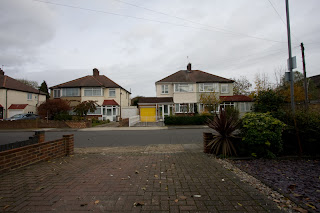Wide angle – canon zoom lens EF-S 10-22mm
Standard lens – Canon zoom lens EFS 17-55
Telephoto lens Canon zoom lens EF 100-400mm L IS crop factor 1.6
I mounted the camera on a tripod and took four images of a house across the street at the following focal lengths:- 10mm, 55mm, 150mm*1.6=240mm and 400mm*1.6=640mm
 |
| 10mm |
I printed off the four images and returned to the same position from which I took the photographs and held the prints up one by one.
When holding up the 10mm image I had to move to within about 3 inches of my nose before the image matched real life size.
The 55mm image image, this matched real life size at about an arms length.
When holding up the 240mm image this matched real life at an estimated distance of 2 arms lenghts
When holding up the 240mm image this matched real life at an estimated distance of 2 arms lenghts
 |
| 55mm |
When holding up the 640mm image, this matched real life at an estimated distance of 3 or more arms lengths.
Information about maths behind the angle of view and focal length can be found at reference 1
Information about maths behind the angle of view and focal length can be found at reference 1
I concluded that a focal length of around 55mm provides a good approximation to real life. There is an inverse relationship between focal length and angle of view in that the angle of view narrows with increasing focal length. This relationship is non-linear as demonstrated by the graph below based on data from reference 2
References



No comments:
Post a Comment